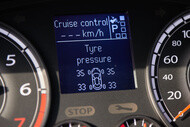
Tips & Advice for Car, SUV & Van tires
The TPMS (Tire Pressure Monitoring System) allows you to detect when your tires are too low in pressure. It has been compulsory in Europe since 1 November 2014 (in the USA since 2007), which means that your vehicle is equipped with it if it was manufactured after this date.
In practical terms, TPMS is able to display your tire pressure level on your dashboard via an indicator or warning light.
How does tire pressure sensor work?
The TPMS can operate on two detection systems: direct and indirect.
Direct system
With the direct system, pressure information is fed back in real time via a tire pressure sensor in the tire or valve. It is sent to the on-board computer to present the information on your dashboard. Depending on your vehicle, it can take a different form:

A warning light or signal light

A representation of your car with the pressure level of your tires
Indirect system
With the indirect system, the tire pressure is calculated by the Tire Pressure Monitoring System on the basis of the wheel rotation speed, which is also used by the ABS (Anti-lock Braking System) and ESP (Electronic Stability Program).
The speed of rotation increases when the diameter of the wheel is reduced due to under-inflation. The information is then sent to the dashboard by the TPMS.
TPMS: advantages and disadvantages
The advantage of this system is that it provides an automatic warning of your tire pressure. You might then think that you don't have to go to the service station every month because the TPMS is there to tell you when it's time to reinflate your tires. But that's not what we recommend.
The TPMS has one drawback: it only activates when your tires have lost 20% of their air, which is about 0.4 bar on average.
Why is this a problem?
Because it is considered that at this pressure level the tire is already under-inflated and it is known that an under-inflated tire leads to premature wear. If your tire wears out prematurely, it will have to be replaced earlier than expected. That means extra costs.
As handy as this indicator is, it is still recommended to check your tire pressure once a month to avoid having to replace your tires prematurely.
How to set the TPMS?
You don't have to do anything special because the warning system has been set to the optimum pressure for your tires. When one of your tires is under-inflated (i.e. when its pressure is less than 20% of its recommended pressure), a light on your dashboard will appear. This is your TPMS indicating which tire on your vehicle is affected.
When should the TPMS be recalibrated?
If you choose a different tire size, it is possible that the recommended pressure is different from the original tire.
In this case, a professional will have to re-set the TPMS so that it alerts you to any drop in pressure related to this new configuration.
Tire pressure sensor replacement
Although the theoretical life span of tire pressure sensors is 5-7 years.
That’s because tire pressure sensors are exposed to corrosion, shocks and high speeds when driving on the motorway.
In the event of a malfunction, you can contact a professional to have the defective tire pressure sensor replaced.



